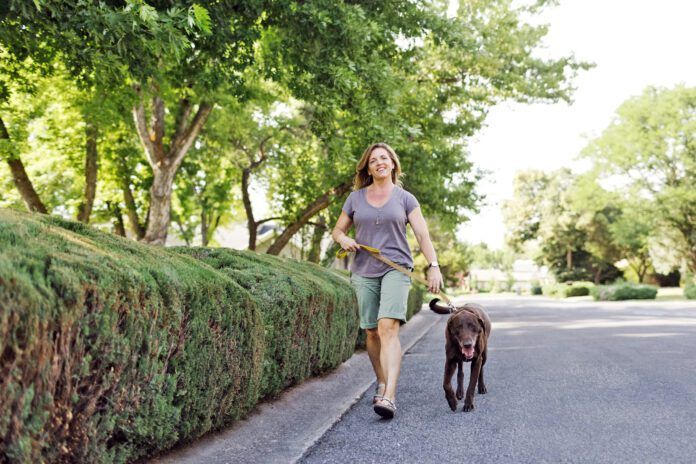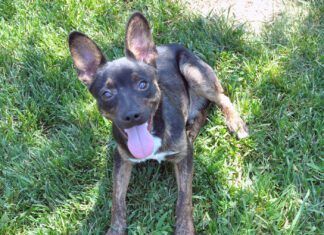Dog walks are the highlight of the day for most dogs. But what about when it’s hot and humid, with the sun beating down on that black asphalt? How do you know if it’s safe to walk your pup then?
Learn to identify the temperature of the area where you want/need to walk. Many experts recommend the “7-second rule.” Place your hand on the pavement/asphalt/surface for 7 seconds. If it’s too hot for you at that time frame or before you even reach 7 seconds, it’s too hot for your dog without protection.
While we find the 7-second rule to be the simplest, if you prefer, you can also use a digital infrared thermometer or consult the chart from the Extension at University of Georgia that lists air temperature and how it affects grass temperature, asphalt temperature, and more. For example, according to the chart, at 2 p.m., on a 91-degree day, the asphalt is 140 degrees. That’s too hot for your dog’s paws. This is your most basic and simplest dog walking temperature chart.
With the information at hand, you can best determine if surfaces like blacktop are too hot for your bare paw dog to walk over.
Summer Dog Walks Are Critical
Walks are important mental enrichment for dogs. It would be a sad thing for dogs to miss them simply because it’s hot outside. Learning how to do this safely is of utmost importance to both the dogs and humans in their lives.
Dog walks don’t always have to be high activity. They just need to be fun for your dog! If you can drive your dogs to a wooded area that offers an abundance of shade and sniffing opportunities, do this.
Bring plenty of water and a bowl for your dog to drink from. Walk slowly and simply allow sniffing and pottying without a goal of getting somewhere. Be mindful of how far away from your vehicle you are walking and allow for the energy needed to get back there safely.
If possible, aim for dirt/grass/mossy terrain versus asphalt and concrete. Know your dog’s limits and breathing abilities and consider their age/overall health/physical fitness levels as well as their color. Dark dogs get hotter faster as do floofy dogs. Double that for a dark floofy dog. Brachycephalic dogs do have breathing handicaps that are even worse when it’s hot.
Schedule Your Dog Walks to Avoid Heat
If you must walk in your own neighborhood that consists of primarily concrete or asphalt surfaces, do the longer walks early in the morning or later at night when it’s a bit cooler.
Make additional potty breaks short and purposeful. Invest in a paw protectant like Musher’s Secret, a highly recommended choice. This not only protects paw pads from ice/cold/salt in the winter, but it also protects from heat in the summer. Booties are also an option if your dog will wear them, but most dogs prefer the balm.
Take fresh water and go slowly and stick to grass when you can. The same rules as above apply. Keep it short with the goal of sniffing and pottying.
Provide extra indoor mental enrichment to make up for shorter walks. Examples can include snuffle mats, lick mats, puzzle toys, search games, and training time.
Tips to Make Hot-Day Dog Walks Safer
- When it’s hot, do not take lengthy walks or runs. It doesn’t matter whether you can handle this heat, your dog cannot.
- Take extra care with brachycephalic breeds like Pugs and Frenchies. These dogs cannot breathe normally. Don’t place them in danger.
- Never leave dogs in your yard unattended in overly warm temperatures for longer than a very short time. Make sure that there is adequate shade available as well as fresh water and even a doggy pool if your dog enjoys such.
- Check on them frequently, meaning every few minutes in some cases. It doesn’t take long for a heat-related issue to surface.
- And, of course, never leave your dog in a vehicle in hot and humid temperatures for even a literal minute, even with AC on. In high-humidity temperatures, the AC and the car will be less reliable.






